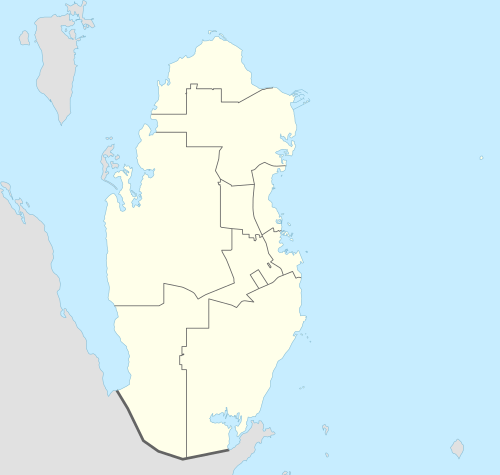Al Jemailiya
| Al Jemailiya | |
|---|---|
| Settlement | |
 Al Jemailiya | |
| Coordinates: QA 25°37′15″N 51°4′55″E / 25.62083°N 51.08194°ECoordinates: QA 25°37′15″N 51°4′55″E / 25.62083°N 51.08194°E | |
| Country | Qatar |
| Municipality | Al Rayyan |
| Area | |
| • Total | 626.2 km2 (241.8 sq mi) |
| Population | |
| • Total | 1,706 |
| • Density | 2.7/km2 (7.1/sq mi) |
Al Jemailiya is a settlement in Qatar, located in the municipality of Al Rayyan.[1] It used to be the seat of Al Jemailiya Municipality before it was incorporated into Al Rayyan Municipality.[2]
Demographics
As of the 2010 census, the settlement comprised 429 housing units[3] and 190 establishments.[4] There were 1,706 people living in the settlement, of which 60% were male and 40% were female. Out of the 1,706 inhabitants, 71% were 20 years of age or older and 29% were under the age of 20. The literacy rate stood at 91.5%.[5]
Employed persons made up 59% of the total population. Females accounted for 27% of the working population, while males accounted for 73% of the working population.[5]
| Year | Population |
|---|---|
| 1986[6] | 1,636 |
| 1997[7] | 1,303 |
| 2004[2] | 1,367 |
| 2010[1] | 1,706 |
Visitor attractions
Mosques
There are a number of mosques dating to the mid-20th century in the settlement. As a result of mass migration to the capital Doha over the years, most mosques were deserted.[8]
Bin Duham Mosque, erected in 1942, is one of the few dilapidated mosques in Al Jemailiyah. It has two entrances on the north and south side, respectively. The minaret, situated in the north-east section, lies on a thin base and is barrel-shaped. An outdoor prayer area is accessible through four pathways in the courtyard, while the prayer hall has three entrances leading from the outdoor area. The roof covering the prayer areas was constructed using plaited reed mats overlain with a mixture of mud and straw.[8]
Another old mosque in the village is Al Suwaheet Mosque, which was constructed in 1940. It has two entrances in the east and south, respectively. Its minaret extends 7.3 high and is separated into three segments of nearly equal size. The outdoor prayer area can be accessed through five rectangular pathways in the courtyard. There is also an indoor prayer hall.[9]
The oldest and smallest mosque is Al Amiri Mosque. Opened in 1939, it continued to remain in operation after the abandonment of the other mosques. It has a southern and northern entrance. The minaret is small and has a narrow base with no ornamental markings. There are outer and inner prayer areas. The mosque has undergone a number of renovations in its history, resulting in its roof being overlain with corrugated metal and concrete block pathways being created for the open prayer area.[10]
Education
The follows schools are located in Al Jemailiya:
| Name of School | Curriculum | Grade | Genders | Official Website | Ref |
|---|---|---|---|---|---|
| Al Jumailiya Girls Schools | Independent | Primary – Secondary | Female-only | N/A | [11] |
| Al Jumailiya Boys Schools | Independent | Primary – Secondary | Male-only | N/A | [11] |
References
- 1 2 "2010 population census" (PDF). Qatar Statistics Authority. Retrieved 29 June 2015.
- 1 2 "2004 population census". Qatar Statistics Authority. Retrieved 1 July 2015.
- ↑ "Housing units, by type of unit and zone (April 2010)" (PDF). Qatar Statistics Authority. Retrieved 7 August 2015.
- ↑ "Establishments by status of establishment and zone (April 2010)" (PDF). Qatar Statistics Authority. Retrieved 7 August 2015.
- 1 2 "Geo Statistics Application". Ministry of Development Planning and Statistics. Retrieved 7 August 2015.
- ↑ "1986 population census" (PDF). Qatar Statistics Authority. Retrieved 2 July 2015.
- ↑ "1997 population census" (PDF). Qatar Statistics Authority. Retrieved 2 July 2015.
- 1 2 Jaidah, Ibrahim; Bourennane, Malika (2010). The History of Qatari Architecture 1800-1950. Skira. p. 252. ISBN 978-8861307933.
- ↑ Jaidah, Ibrahim; Bourennane, Malika (2010). The History of Qatari Architecture 1800-1950. Skira. p. 256. ISBN 978-8861307933.
- ↑ Jaidah, Ibrahim; Bourennane, Malika (2010). The History of Qatari Architecture 1800-1950. Skira. p. 262. ISBN 978-8861307933.
- 1 2 "Qatari Schools". Supreme Education Council. Retrieved 18 July 2015.